The Meritocracy Myth: Exploring Non-Merit Factors and Their Influence
VerifiedAdded on 2023/01/16
|8
|1979
|80
Essay
AI Summary
This essay critically examines the meritocracy myth, which posits that societal success and advancement are solely determined by individual merit, such as hard work, talent, and ability. The author, drawing on the work of Mc Namee and Miller, argues against the existence of pure meritocracy due to the influence of non-merit factors. The essay explores various non-merit factors that hinder individual mobility, including inheritance, education, social capital, luck, discrimination, and cultural capital. It also discusses the impact of self-employment decline, political influence, and the concentration of wealth. The author argues that while meritocracy is an ideal, it is unattainable in its purest form due to these factors and suggests ways to make it more genuine, such as reducing discrimination and redistributing resources. The essay further examines how these non-merit factors affect student education and performance. The essay concludes by emphasizing the incomplete explanation of success and failure provided by the meritocracy myth, as well as the need for a more nuanced understanding of societal structures.
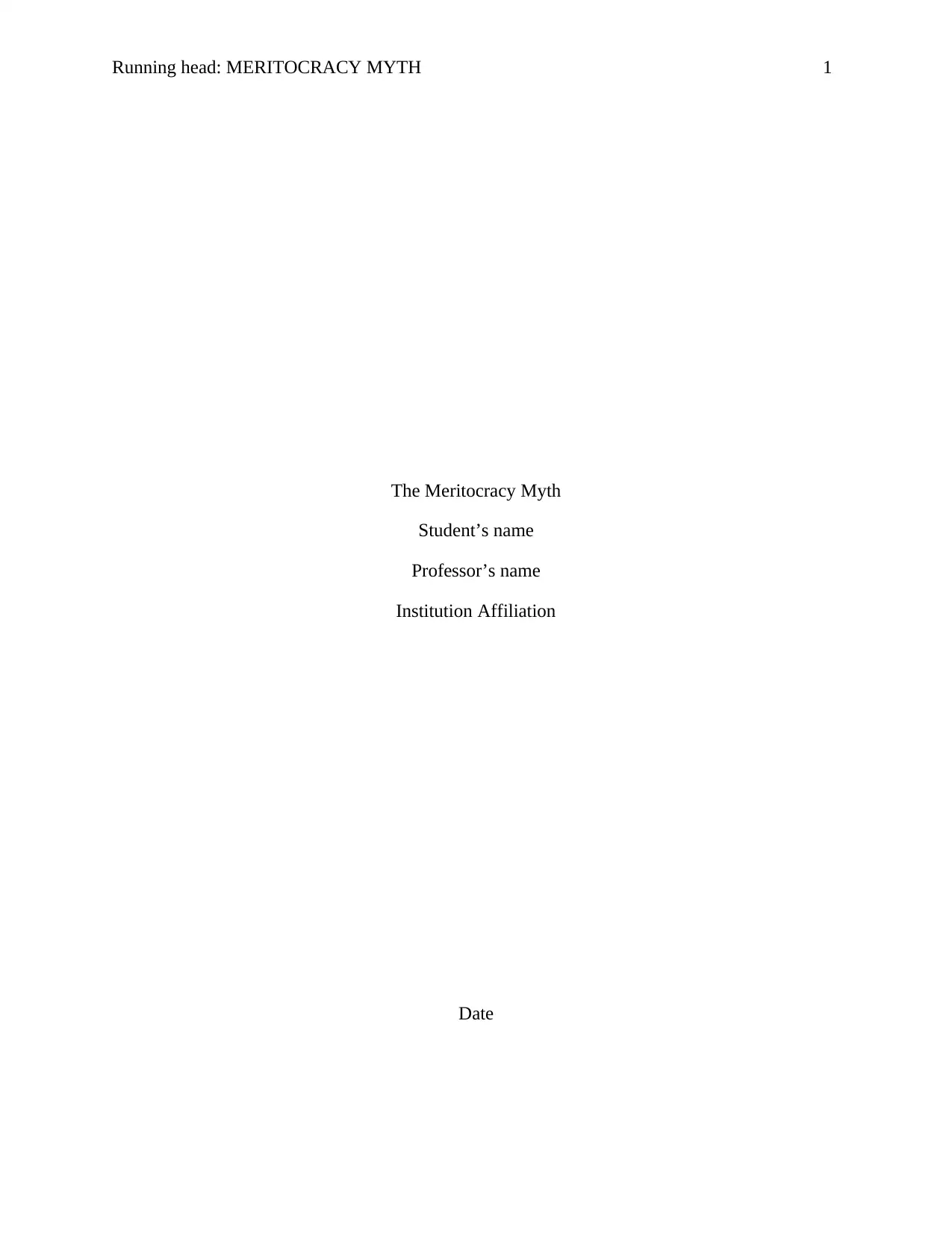
Running head: MERITOCRACY MYTH 1
The Meritocracy Myth
Student’s name
Professor’s name
Institution Affiliation
Date
The Meritocracy Myth
Student’s name
Professor’s name
Institution Affiliation
Date
Paraphrase This Document
Need a fresh take? Get an instant paraphrase of this document with our AI Paraphraser
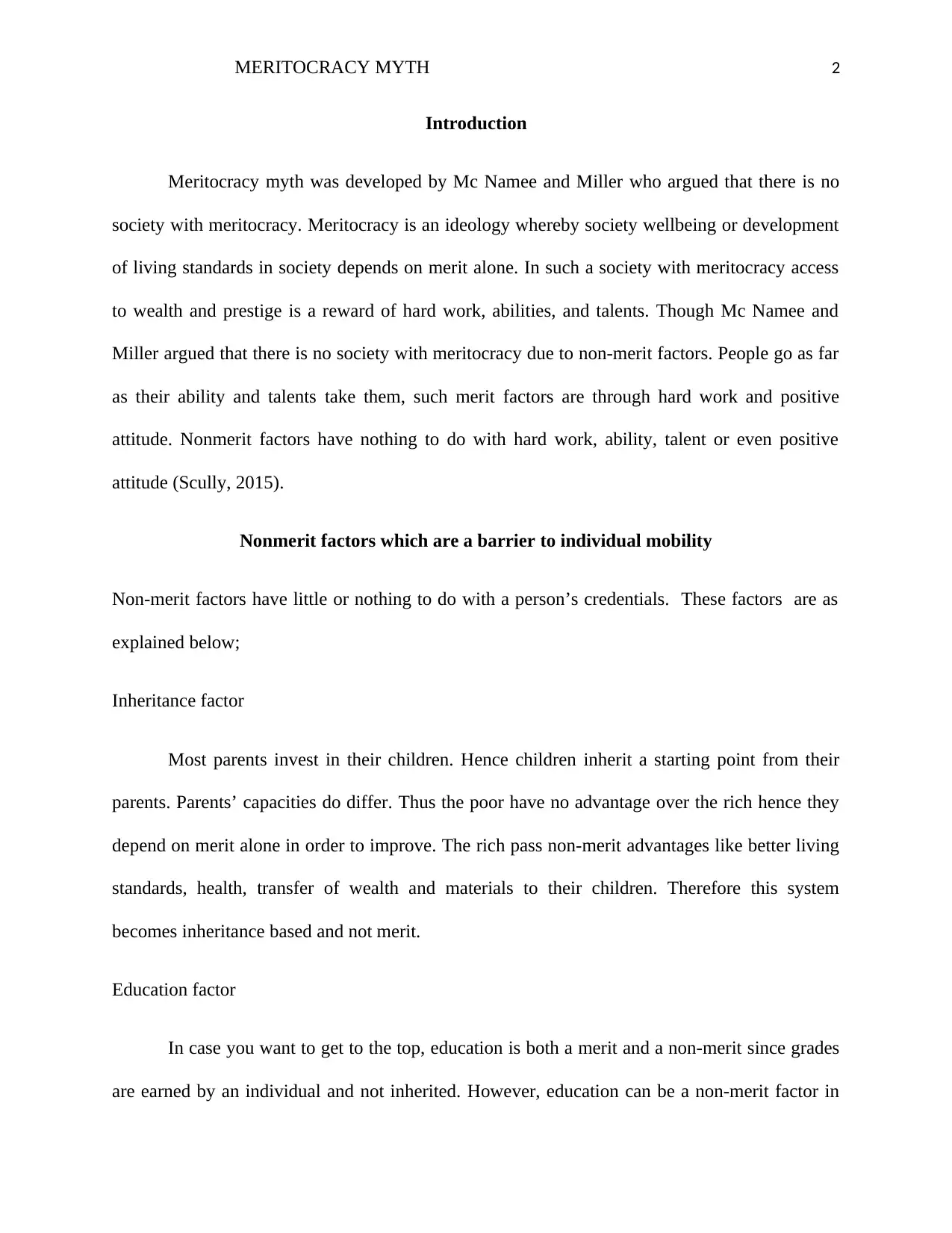
MERITOCRACY MYTH 2
Introduction
Meritocracy myth was developed by Mc Namee and Miller who argued that there is no
society with meritocracy. Meritocracy is an ideology whereby society wellbeing or development
of living standards in society depends on merit alone. In such a society with meritocracy access
to wealth and prestige is a reward of hard work, abilities, and talents. Though Mc Namee and
Miller argued that there is no society with meritocracy due to non-merit factors. People go as far
as their ability and talents take them, such merit factors are through hard work and positive
attitude. Nonmerit factors have nothing to do with hard work, ability, talent or even positive
attitude (Scully, 2015).
Nonmerit factors which are a barrier to individual mobility
Non-merit factors have little or nothing to do with a person’s credentials. These factors are as
explained below;
Inheritance factor
Most parents invest in their children. Hence children inherit a starting point from their
parents. Parents’ capacities do differ. Thus the poor have no advantage over the rich hence they
depend on merit alone in order to improve. The rich pass non-merit advantages like better living
standards, health, transfer of wealth and materials to their children. Therefore this system
becomes inheritance based and not merit.
Education factor
In case you want to get to the top, education is both a merit and a non-merit since grades
are earned by an individual and not inherited. However, education can be a non-merit factor in
Introduction
Meritocracy myth was developed by Mc Namee and Miller who argued that there is no
society with meritocracy. Meritocracy is an ideology whereby society wellbeing or development
of living standards in society depends on merit alone. In such a society with meritocracy access
to wealth and prestige is a reward of hard work, abilities, and talents. Though Mc Namee and
Miller argued that there is no society with meritocracy due to non-merit factors. People go as far
as their ability and talents take them, such merit factors are through hard work and positive
attitude. Nonmerit factors have nothing to do with hard work, ability, talent or even positive
attitude (Scully, 2015).
Nonmerit factors which are a barrier to individual mobility
Non-merit factors have little or nothing to do with a person’s credentials. These factors are as
explained below;
Inheritance factor
Most parents invest in their children. Hence children inherit a starting point from their
parents. Parents’ capacities do differ. Thus the poor have no advantage over the rich hence they
depend on merit alone in order to improve. The rich pass non-merit advantages like better living
standards, health, transfer of wealth and materials to their children. Therefore this system
becomes inheritance based and not merit.
Education factor
In case you want to get to the top, education is both a merit and a non-merit since grades
are earned by an individual and not inherited. However, education can be a non-merit factor in
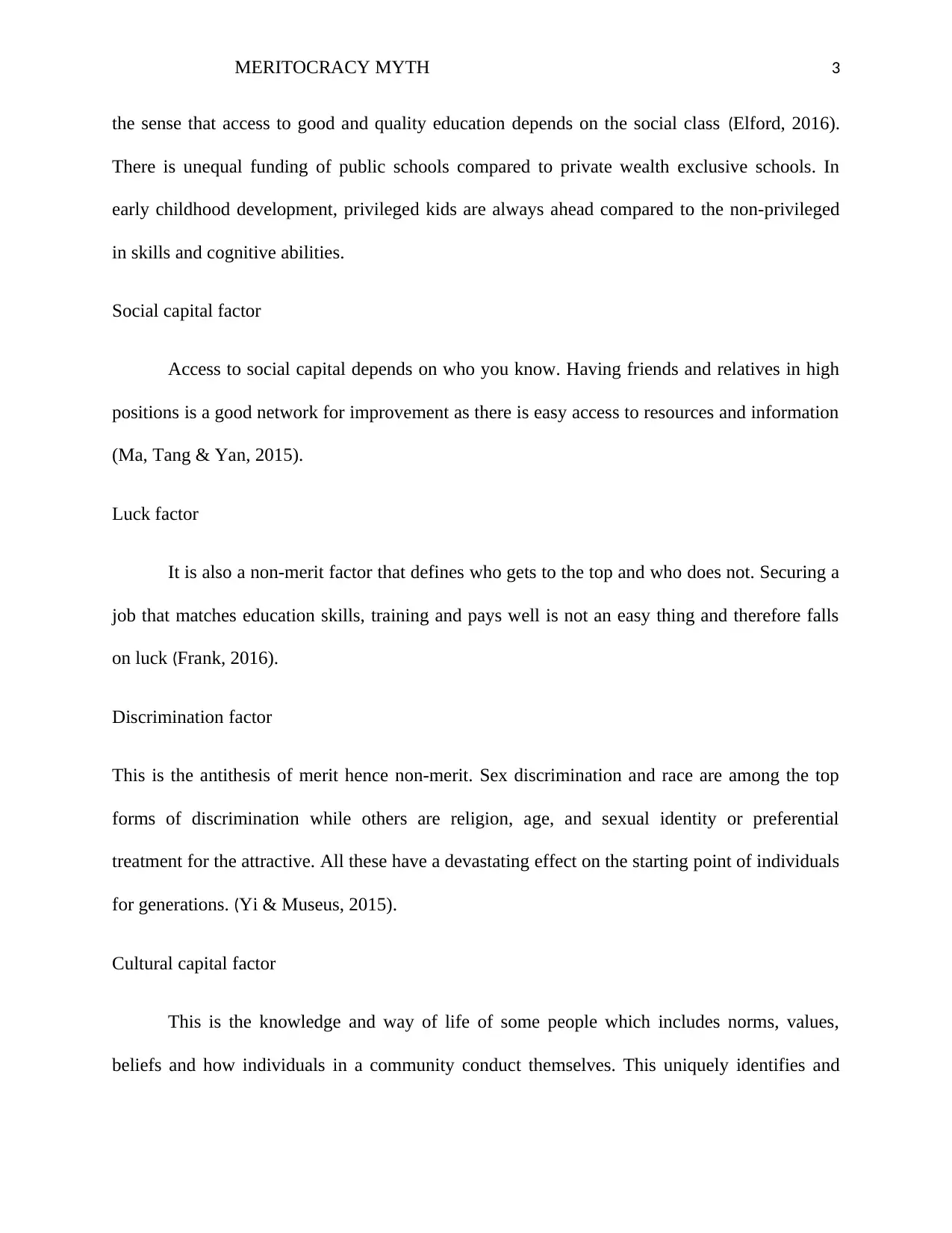
MERITOCRACY MYTH 3
the sense that access to good and quality education depends on the social class (Elford, 2016).
There is unequal funding of public schools compared to private wealth exclusive schools. In
early childhood development, privileged kids are always ahead compared to the non-privileged
in skills and cognitive abilities.
Social capital factor
Access to social capital depends on who you know. Having friends and relatives in high
positions is a good network for improvement as there is easy access to resources and information
(Ma, Tang & Yan, 2015).
Luck factor
It is also a non-merit factor that defines who gets to the top and who does not. Securing a
job that matches education skills, training and pays well is not an easy thing and therefore falls
on luck (Frank, 2016).
Discrimination factor
This is the antithesis of merit hence non-merit. Sex discrimination and race are among the top
forms of discrimination while others are religion, age, and sexual identity or preferential
treatment for the attractive. All these have a devastating effect on the starting point of individuals
for generations. (Yi & Museus, 2015).
Cultural capital factor
This is the knowledge and way of life of some people which includes norms, values,
beliefs and how individuals in a community conduct themselves. This uniquely identifies and
the sense that access to good and quality education depends on the social class (Elford, 2016).
There is unequal funding of public schools compared to private wealth exclusive schools. In
early childhood development, privileged kids are always ahead compared to the non-privileged
in skills and cognitive abilities.
Social capital factor
Access to social capital depends on who you know. Having friends and relatives in high
positions is a good network for improvement as there is easy access to resources and information
(Ma, Tang & Yan, 2015).
Luck factor
It is also a non-merit factor that defines who gets to the top and who does not. Securing a
job that matches education skills, training and pays well is not an easy thing and therefore falls
on luck (Frank, 2016).
Discrimination factor
This is the antithesis of merit hence non-merit. Sex discrimination and race are among the top
forms of discrimination while others are religion, age, and sexual identity or preferential
treatment for the attractive. All these have a devastating effect on the starting point of individuals
for generations. (Yi & Museus, 2015).
Cultural capital factor
This is the knowledge and way of life of some people which includes norms, values,
beliefs and how individuals in a community conduct themselves. This uniquely identifies and
⊘ This is a preview!⊘
Do you want full access?
Subscribe today to unlock all pages.

Trusted by 1+ million students worldwide
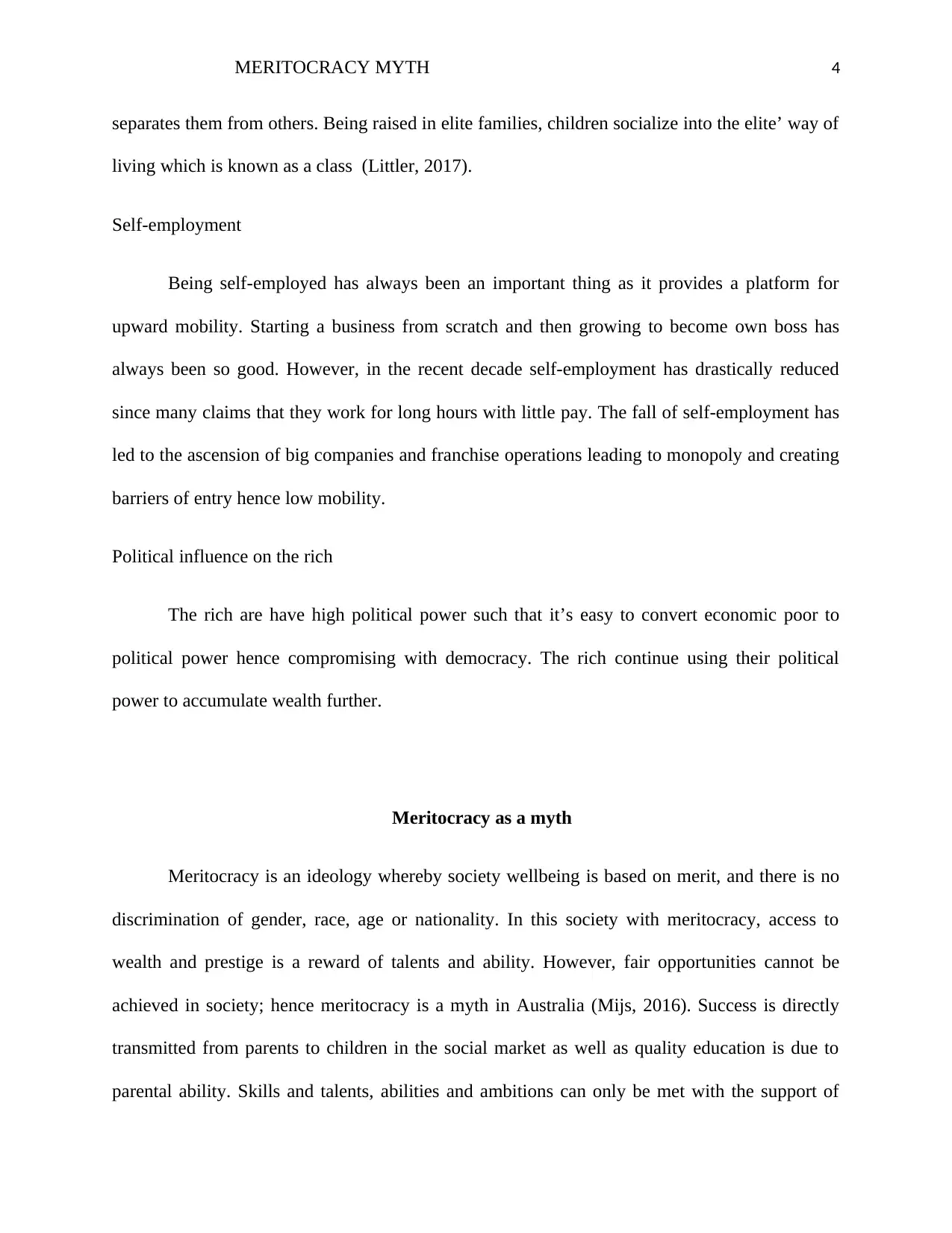
MERITOCRACY MYTH 4
separates them from others. Being raised in elite families, children socialize into the elite’ way of
living which is known as a class (Littler, 2017).
Self-employment
Being self-employed has always been an important thing as it provides a platform for
upward mobility. Starting a business from scratch and then growing to become own boss has
always been so good. However, in the recent decade self-employment has drastically reduced
since many claims that they work for long hours with little pay. The fall of self-employment has
led to the ascension of big companies and franchise operations leading to monopoly and creating
barriers of entry hence low mobility.
Political influence on the rich
The rich are have high political power such that it’s easy to convert economic poor to
political power hence compromising with democracy. The rich continue using their political
power to accumulate wealth further.
Meritocracy as a myth
Meritocracy is an ideology whereby society wellbeing is based on merit, and there is no
discrimination of gender, race, age or nationality. In this society with meritocracy, access to
wealth and prestige is a reward of talents and ability. However, fair opportunities cannot be
achieved in society; hence meritocracy is a myth in Australia (Mijs, 2016). Success is directly
transmitted from parents to children in the social market as well as quality education is due to
parental ability. Skills and talents, abilities and ambitions can only be met with the support of
separates them from others. Being raised in elite families, children socialize into the elite’ way of
living which is known as a class (Littler, 2017).
Self-employment
Being self-employed has always been an important thing as it provides a platform for
upward mobility. Starting a business from scratch and then growing to become own boss has
always been so good. However, in the recent decade self-employment has drastically reduced
since many claims that they work for long hours with little pay. The fall of self-employment has
led to the ascension of big companies and franchise operations leading to monopoly and creating
barriers of entry hence low mobility.
Political influence on the rich
The rich are have high political power such that it’s easy to convert economic poor to
political power hence compromising with democracy. The rich continue using their political
power to accumulate wealth further.
Meritocracy as a myth
Meritocracy is an ideology whereby society wellbeing is based on merit, and there is no
discrimination of gender, race, age or nationality. In this society with meritocracy, access to
wealth and prestige is a reward of talents and ability. However, fair opportunities cannot be
achieved in society; hence meritocracy is a myth in Australia (Mijs, 2016). Success is directly
transmitted from parents to children in the social market as well as quality education is due to
parental ability. Skills and talents, abilities and ambitions can only be met with the support of
Paraphrase This Document
Need a fresh take? Get an instant paraphrase of this document with our AI Paraphraser
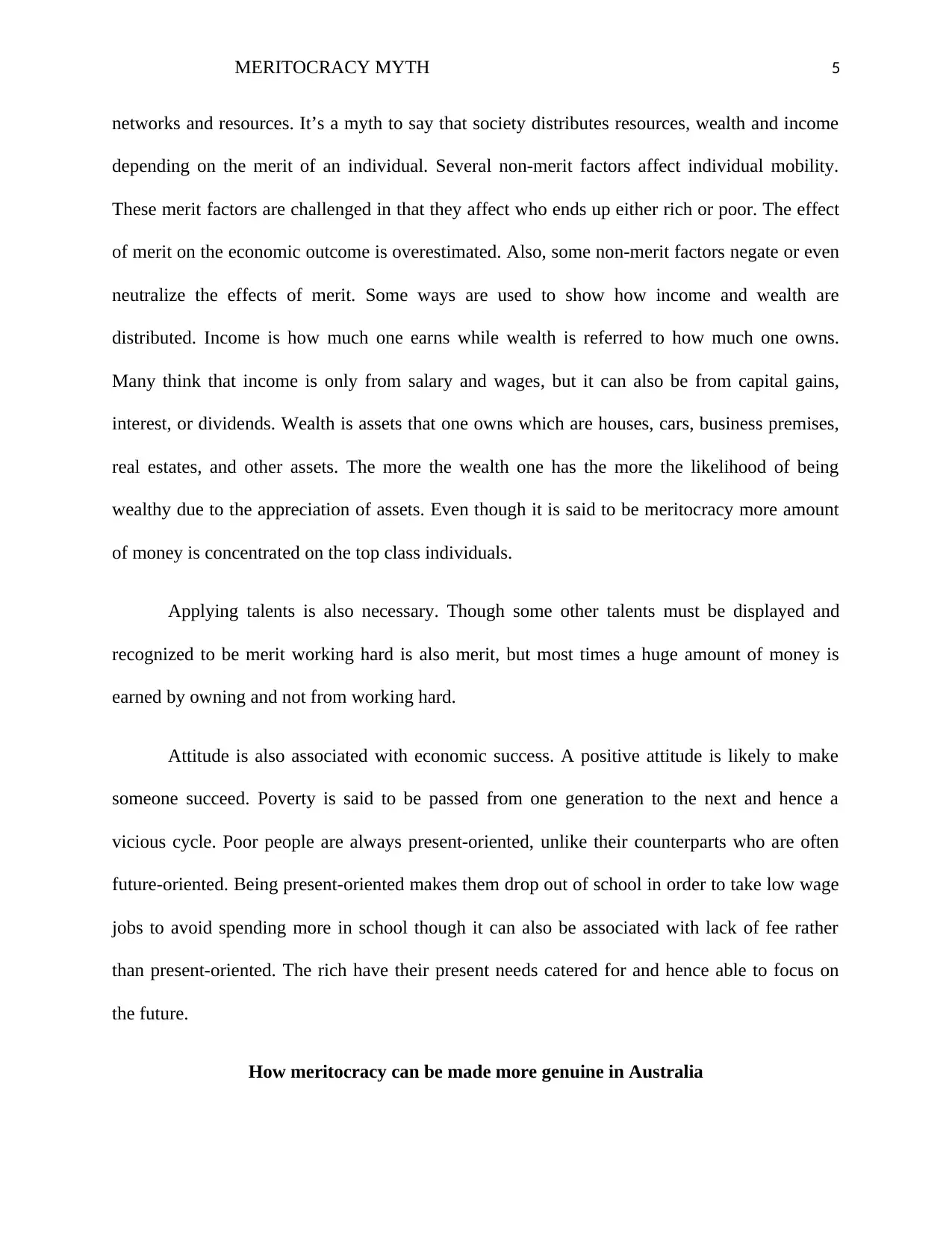
MERITOCRACY MYTH 5
networks and resources. It’s a myth to say that society distributes resources, wealth and income
depending on the merit of an individual. Several non-merit factors affect individual mobility.
These merit factors are challenged in that they affect who ends up either rich or poor. The effect
of merit on the economic outcome is overestimated. Also, some non-merit factors negate or even
neutralize the effects of merit. Some ways are used to show how income and wealth are
distributed. Income is how much one earns while wealth is referred to how much one owns.
Many think that income is only from salary and wages, but it can also be from capital gains,
interest, or dividends. Wealth is assets that one owns which are houses, cars, business premises,
real estates, and other assets. The more the wealth one has the more the likelihood of being
wealthy due to the appreciation of assets. Even though it is said to be meritocracy more amount
of money is concentrated on the top class individuals.
Applying talents is also necessary. Though some other talents must be displayed and
recognized to be merit working hard is also merit, but most times a huge amount of money is
earned by owning and not from working hard.
Attitude is also associated with economic success. A positive attitude is likely to make
someone succeed. Poverty is said to be passed from one generation to the next and hence a
vicious cycle. Poor people are always present-oriented, unlike their counterparts who are often
future-oriented. Being present-oriented makes them drop out of school in order to take low wage
jobs to avoid spending more in school though it can also be associated with lack of fee rather
than present-oriented. The rich have their present needs catered for and hence able to focus on
the future.
How meritocracy can be made more genuine in Australia
networks and resources. It’s a myth to say that society distributes resources, wealth and income
depending on the merit of an individual. Several non-merit factors affect individual mobility.
These merit factors are challenged in that they affect who ends up either rich or poor. The effect
of merit on the economic outcome is overestimated. Also, some non-merit factors negate or even
neutralize the effects of merit. Some ways are used to show how income and wealth are
distributed. Income is how much one earns while wealth is referred to how much one owns.
Many think that income is only from salary and wages, but it can also be from capital gains,
interest, or dividends. Wealth is assets that one owns which are houses, cars, business premises,
real estates, and other assets. The more the wealth one has the more the likelihood of being
wealthy due to the appreciation of assets. Even though it is said to be meritocracy more amount
of money is concentrated on the top class individuals.
Applying talents is also necessary. Though some other talents must be displayed and
recognized to be merit working hard is also merit, but most times a huge amount of money is
earned by owning and not from working hard.
Attitude is also associated with economic success. A positive attitude is likely to make
someone succeed. Poverty is said to be passed from one generation to the next and hence a
vicious cycle. Poor people are always present-oriented, unlike their counterparts who are often
future-oriented. Being present-oriented makes them drop out of school in order to take low wage
jobs to avoid spending more in school though it can also be associated with lack of fee rather
than present-oriented. The rich have their present needs catered for and hence able to focus on
the future.
How meritocracy can be made more genuine in Australia
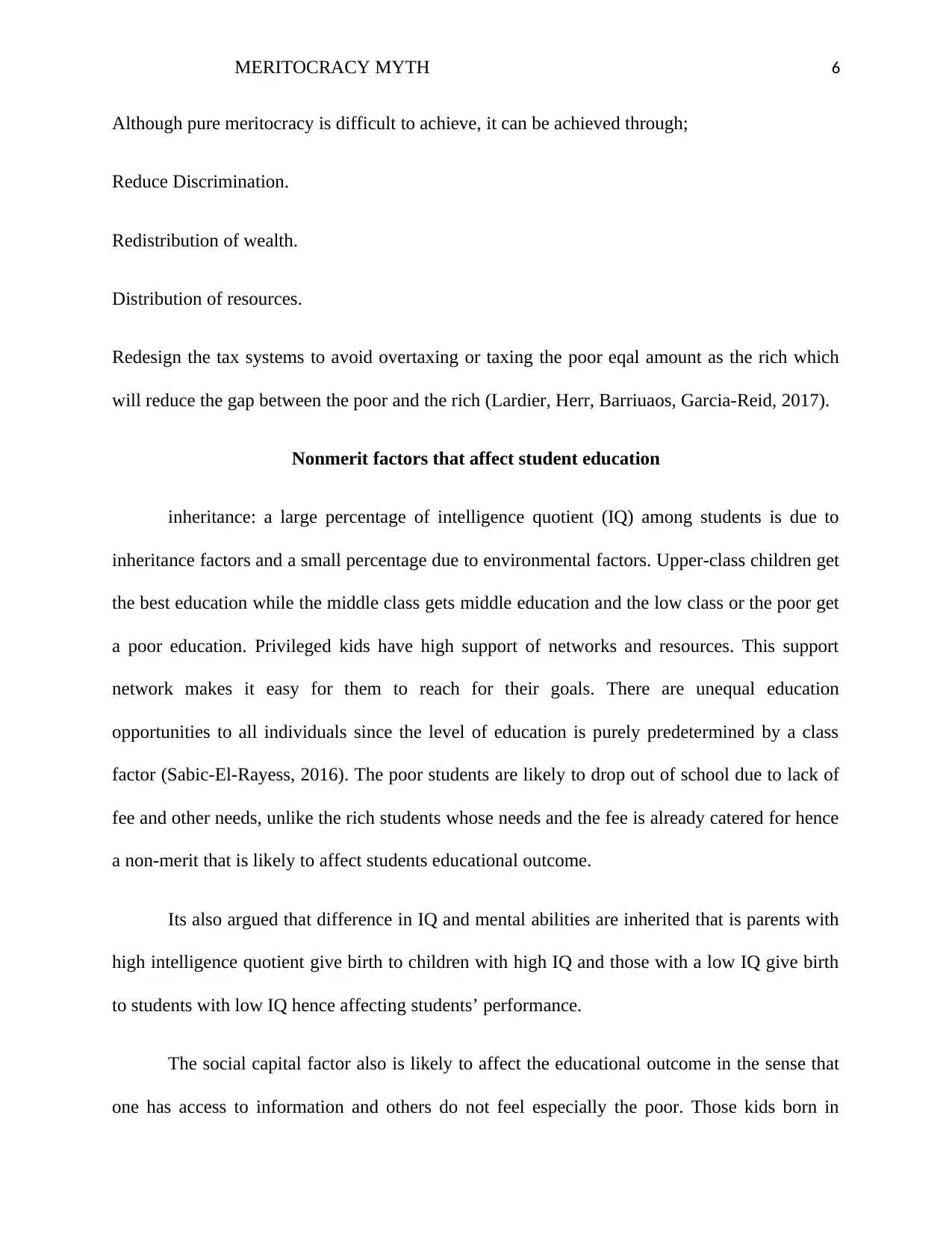
MERITOCRACY MYTH 6
Although pure meritocracy is difficult to achieve, it can be achieved through;
Reduce Discrimination.
Redistribution of wealth.
Distribution of resources.
Redesign the tax systems to avoid overtaxing or taxing the poor eqal amount as the rich which
will reduce the gap between the poor and the rich (Lardier, Herr, Barriuaos, Garcia-Reid, 2017).
Nonmerit factors that affect student education
inheritance: a large percentage of intelligence quotient (IQ) among students is due to
inheritance factors and a small percentage due to environmental factors. Upper-class children get
the best education while the middle class gets middle education and the low class or the poor get
a poor education. Privileged kids have high support of networks and resources. This support
network makes it easy for them to reach for their goals. There are unequal education
opportunities to all individuals since the level of education is purely predetermined by a class
factor (Sabic-El-Rayess, 2016). The poor students are likely to drop out of school due to lack of
fee and other needs, unlike the rich students whose needs and the fee is already catered for hence
a non-merit that is likely to affect students educational outcome.
Its also argued that difference in IQ and mental abilities are inherited that is parents with
high intelligence quotient give birth to children with high IQ and those with a low IQ give birth
to students with low IQ hence affecting students’ performance.
The social capital factor also is likely to affect the educational outcome in the sense that
one has access to information and others do not feel especially the poor. Those kids born in
Although pure meritocracy is difficult to achieve, it can be achieved through;
Reduce Discrimination.
Redistribution of wealth.
Distribution of resources.
Redesign the tax systems to avoid overtaxing or taxing the poor eqal amount as the rich which
will reduce the gap between the poor and the rich (Lardier, Herr, Barriuaos, Garcia-Reid, 2017).
Nonmerit factors that affect student education
inheritance: a large percentage of intelligence quotient (IQ) among students is due to
inheritance factors and a small percentage due to environmental factors. Upper-class children get
the best education while the middle class gets middle education and the low class or the poor get
a poor education. Privileged kids have high support of networks and resources. This support
network makes it easy for them to reach for their goals. There are unequal education
opportunities to all individuals since the level of education is purely predetermined by a class
factor (Sabic-El-Rayess, 2016). The poor students are likely to drop out of school due to lack of
fee and other needs, unlike the rich students whose needs and the fee is already catered for hence
a non-merit that is likely to affect students educational outcome.
Its also argued that difference in IQ and mental abilities are inherited that is parents with
high intelligence quotient give birth to children with high IQ and those with a low IQ give birth
to students with low IQ hence affecting students’ performance.
The social capital factor also is likely to affect the educational outcome in the sense that
one has access to information and others do not feel especially the poor. Those kids born in
⊘ This is a preview!⊘
Do you want full access?
Subscribe today to unlock all pages.

Trusted by 1+ million students worldwide
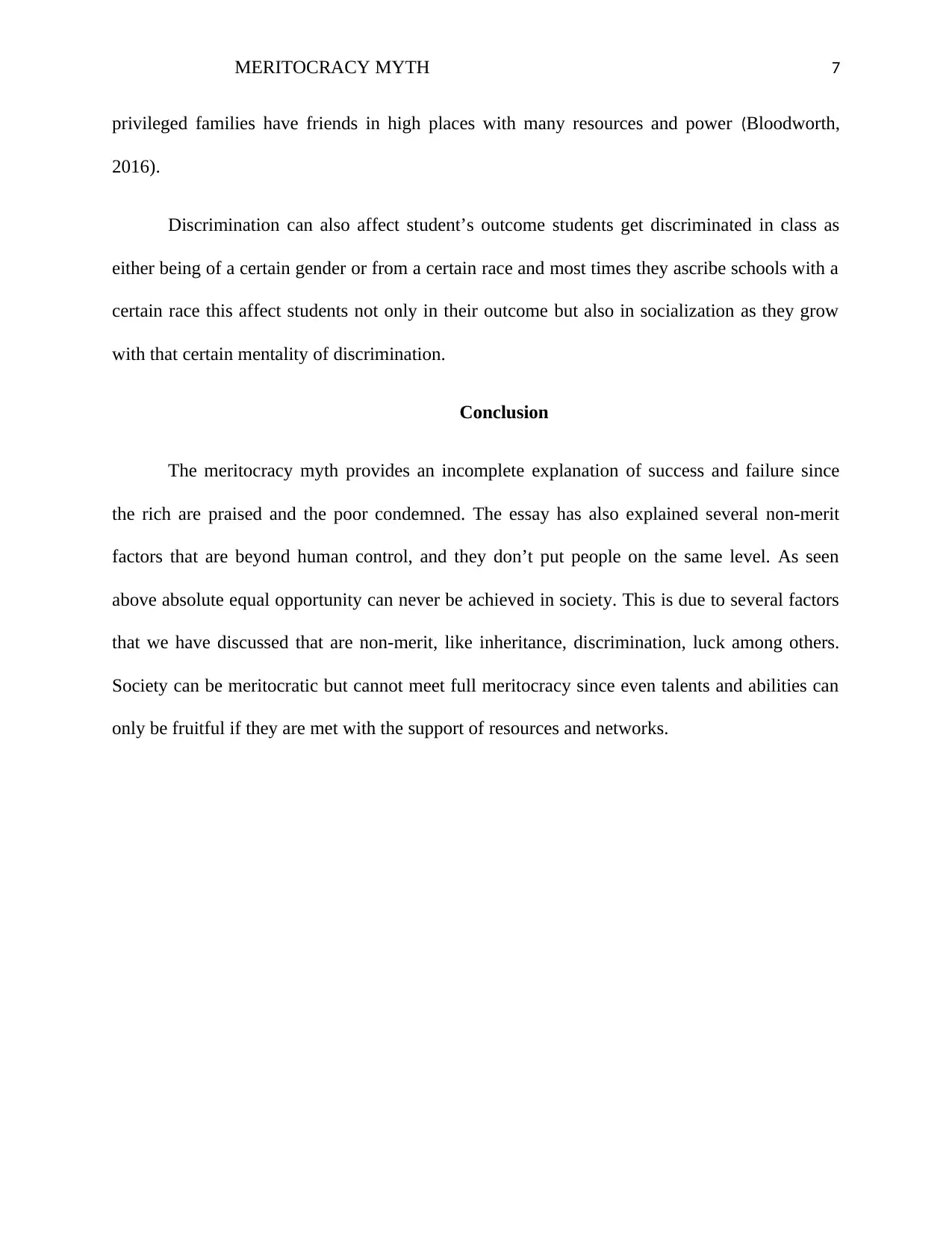
MERITOCRACY MYTH 7
privileged families have friends in high places with many resources and power (Bloodworth,
2016).
Discrimination can also affect student’s outcome students get discriminated in class as
either being of a certain gender or from a certain race and most times they ascribe schools with a
certain race this affect students not only in their outcome but also in socialization as they grow
with that certain mentality of discrimination.
Conclusion
The meritocracy myth provides an incomplete explanation of success and failure since
the rich are praised and the poor condemned. The essay has also explained several non-merit
factors that are beyond human control, and they don’t put people on the same level. As seen
above absolute equal opportunity can never be achieved in society. This is due to several factors
that we have discussed that are non-merit, like inheritance, discrimination, luck among others.
Society can be meritocratic but cannot meet full meritocracy since even talents and abilities can
only be fruitful if they are met with the support of resources and networks.
privileged families have friends in high places with many resources and power (Bloodworth,
2016).
Discrimination can also affect student’s outcome students get discriminated in class as
either being of a certain gender or from a certain race and most times they ascribe schools with a
certain race this affect students not only in their outcome but also in socialization as they grow
with that certain mentality of discrimination.
Conclusion
The meritocracy myth provides an incomplete explanation of success and failure since
the rich are praised and the poor condemned. The essay has also explained several non-merit
factors that are beyond human control, and they don’t put people on the same level. As seen
above absolute equal opportunity can never be achieved in society. This is due to several factors
that we have discussed that are non-merit, like inheritance, discrimination, luck among others.
Society can be meritocratic but cannot meet full meritocracy since even talents and abilities can
only be fruitful if they are met with the support of resources and networks.
Paraphrase This Document
Need a fresh take? Get an instant paraphrase of this document with our AI Paraphraser
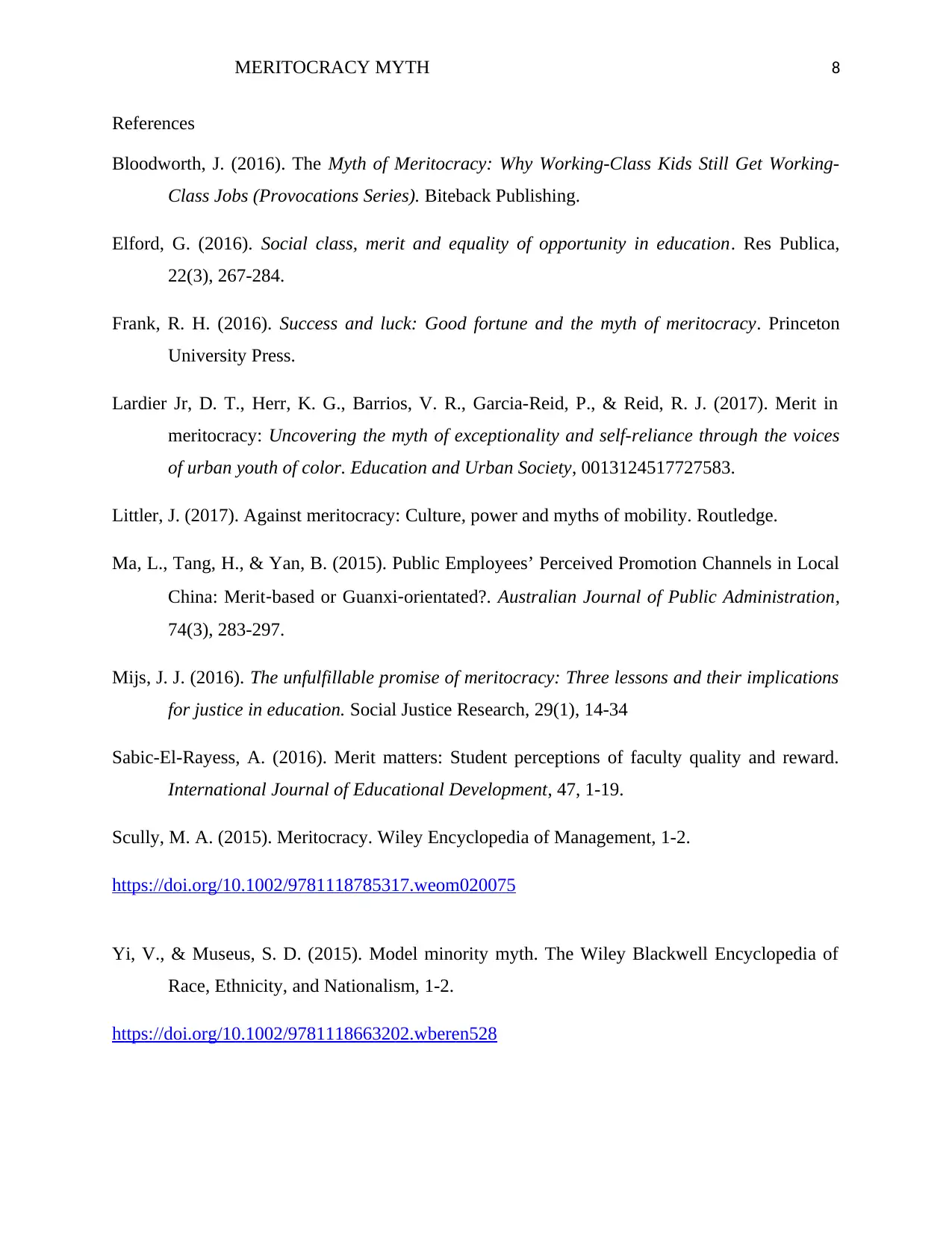
MERITOCRACY MYTH 8
References
Bloodworth, J. (2016). The Myth of Meritocracy: Why Working-Class Kids Still Get Working-
Class Jobs (Provocations Series). Biteback Publishing.
Elford, G. (2016). Social class, merit and equality of opportunity in education. Res Publica,
22(3), 267-284.
Frank, R. H. (2016). Success and luck: Good fortune and the myth of meritocracy. Princeton
University Press.
Lardier Jr, D. T., Herr, K. G., Barrios, V. R., Garcia-Reid, P., & Reid, R. J. (2017). Merit in
meritocracy: Uncovering the myth of exceptionality and self-reliance through the voices
of urban youth of color. Education and Urban Society, 0013124517727583.
Littler, J. (2017). Against meritocracy: Culture, power and myths of mobility. Routledge.
Ma, L., Tang, H., & Yan, B. (2015). Public Employees’ Perceived Promotion Channels in Local
China: Merit‐based or Guanxi‐orientated?. Australian Journal of Public Administration,
74(3), 283-297.
Mijs, J. J. (2016). The unfulfillable promise of meritocracy: Three lessons and their implications
for justice in education. Social Justice Research, 29(1), 14-34
Sabic-El-Rayess, A. (2016). Merit matters: Student perceptions of faculty quality and reward.
International Journal of Educational Development, 47, 1-19.
Scully, M. A. (2015). Meritocracy. Wiley Encyclopedia of Management, 1-2.
https://doi.org/10.1002/9781118785317.weom020075
Yi, V., & Museus, S. D. (2015). Model minority myth. The Wiley Blackwell Encyclopedia of
Race, Ethnicity, and Nationalism, 1-2.
https://doi.org/10.1002/9781118663202.wberen528
References
Bloodworth, J. (2016). The Myth of Meritocracy: Why Working-Class Kids Still Get Working-
Class Jobs (Provocations Series). Biteback Publishing.
Elford, G. (2016). Social class, merit and equality of opportunity in education. Res Publica,
22(3), 267-284.
Frank, R. H. (2016). Success and luck: Good fortune and the myth of meritocracy. Princeton
University Press.
Lardier Jr, D. T., Herr, K. G., Barrios, V. R., Garcia-Reid, P., & Reid, R. J. (2017). Merit in
meritocracy: Uncovering the myth of exceptionality and self-reliance through the voices
of urban youth of color. Education and Urban Society, 0013124517727583.
Littler, J. (2017). Against meritocracy: Culture, power and myths of mobility. Routledge.
Ma, L., Tang, H., & Yan, B. (2015). Public Employees’ Perceived Promotion Channels in Local
China: Merit‐based or Guanxi‐orientated?. Australian Journal of Public Administration,
74(3), 283-297.
Mijs, J. J. (2016). The unfulfillable promise of meritocracy: Three lessons and their implications
for justice in education. Social Justice Research, 29(1), 14-34
Sabic-El-Rayess, A. (2016). Merit matters: Student perceptions of faculty quality and reward.
International Journal of Educational Development, 47, 1-19.
Scully, M. A. (2015). Meritocracy. Wiley Encyclopedia of Management, 1-2.
https://doi.org/10.1002/9781118785317.weom020075
Yi, V., & Museus, S. D. (2015). Model minority myth. The Wiley Blackwell Encyclopedia of
Race, Ethnicity, and Nationalism, 1-2.
https://doi.org/10.1002/9781118663202.wberen528
1 out of 8
Related Documents
Your All-in-One AI-Powered Toolkit for Academic Success.
+13062052269
info@desklib.com
Available 24*7 on WhatsApp / Email
![[object Object]](/_next/static/media/star-bottom.7253800d.svg)
Unlock your academic potential
Copyright © 2020–2025 A2Z Services. All Rights Reserved. Developed and managed by ZUCOL.




